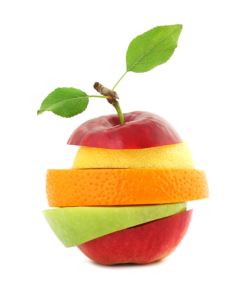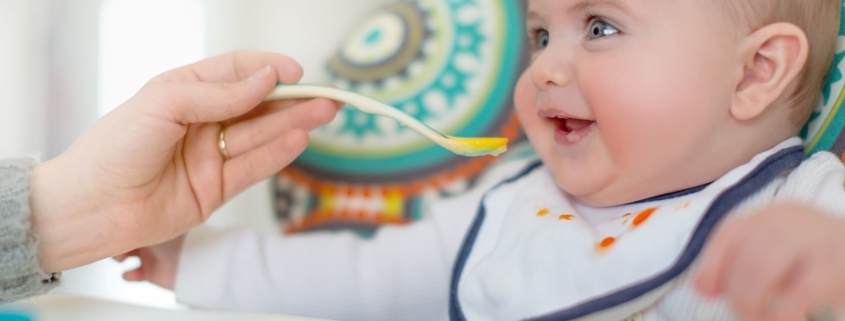Everything You Need To Know About Introducing Solids To Your Baby
As a pediatric feeding therapist introducing solids to your baby is a topic that I talk about a lot. I spend so much time talking with parents about how to know when their baby is ready to start solids. I decided to put some of the must do’s into a list for you.
I consider this list some of the most important “must do’s” when introducing solid foods to your baby. Please keep in mind this list is not the only thing to take into consideration but it is some of the foundation work that will help create a healthy, happy eater.
Introducing Solid Foods To Your Baby Must Do’s
As a feeding therapist, and a Mom, I have seen the difference in introducing solid foods to a baby at 4 months vs 6 months. I believe in starting at 6 months both personally and professionally.
I believe in this because a baby’s skills (that support safe feeding) are more developed at 6 months vs 4 months. Examples of these foundation skills are listed below.
- gross motor (things like holding head up, sitting independently)
- fine motor (things like reaching, grasping, bringing objects to midline and mouthing objects)
- cognitive skills (by 6 months your baby is watching what’s going on around them, watching you eat and bring food to your mouth)
- oral motor skills (more tongue mobility, munching pattern emerging, and gag reflex will start to move back starting around 6 months)
If you started at 4 months and are rocking it then here is a high five. All babies develop differently so this is just a guideline. Trust your gut and observe where your baby is with developing.
How To Make Sure Your Baby Is Supported While Introducing Solids To Your Baby
Make sure your baby is supported in an appropriate highchair. If there is a way for your baby’s legs to be supported then this would be ideal. When we provide stability for your baby’s core (by having feet/legs rested on something) then stability in the mouth can be established.
Imagine trying to eat if you were in a really high bar stool where you couldn’t touch the floor, you might feel a little wobbly and that would leave you looking for the foot rest to give yourself some stability to eat.
If your baby is 6 months then their feet are most likely not hanging down to where you can put something down on the footrest of the highchair (for them to rest flat on). I would take a pillow, flat piece of cardboard, or even a larger book, and place that on the footrest so your baby’s legs/feet are supported
I like this highchair because you can adjust to your needs. I also like this highchair because of the extra support and adjustable footrest.
How To Help Your Baby Play With Pureed Food When Introducing Solids To your Baby
Let your baby play with purees (getting messy is super important for typical feeding development). I would pour a small amount of puree on your baby’s tray and let them pat it, swirl it, and make a mess.
You can also give him/her a spoon (larger/thicker handle type) or a truck/car to roll over the puree and let him play with it. Feeling, smelling, tasting, seeing are all apart of the experience. We eat with all of our senses.
If making a mess gives you a small panic attack then you can do some of these suggestions:
- Take off your baby’s clothes first
- Pick the least stressful or busy time of the day to play and get messy
- Allow your baby to get messy on bath days
- Complete messy play in the bathtub
- Complete messy play in a small pool outside during the summer
- Put a tarp or mat under the highchair to catch anything that falls off
- Find other activities such as playing in sand, birdseed, water, playdough, and with bubbles. Don’t do this in replace of messy food play but allow your baby opportunities for sensory play on non messy food play days
What To Do If Your Baby Is Not Interested In Eating Solids
If your little one appears hesitant (turning away, not engaging, putting hands up,etc) I would start with a dry spoon (Nothing on it) and show your baby how to eat. Actually eat the food off the spoon so your baby can see you.
Then you may want to practice coming to his/her mouth very playfully. You give “kisses” to the spoon or take a “bite” first then go to his/her mouth and place spoon on bottom lip and wait for him/her to open his/her mouth and bring upper lip down to clear spoon.
For when you are taking a “bite”, really take a bite (even with a dry spoon) don’t pretend; your baby needs to see you doing it too. Then you can practice with a small amount of puree on the spoon once they are familiar and open to the spoon coming to them.
But always, always step back and ask “WHY”. Why is my baby not interested in eating? Why is my baby crying and pushing way or tensing up? There is always a reason a baby won’t or doesn’t want to eat. They are born with the ability to protect themselves. We need to make sure we are investigating why first.
5 Signs Your Baby IS Interested In Eating
- Your baby is leaning forward
- Your baby is looking at you
- Your baby has her mouth open or opens in response to spoon
- Your baby is calm and hands are open and relaxed
- Your baby is happy and appears to be interested in you and the food
Signs Your Baby Is Not Interested In Eating
Most importantly we want your baby to be happy, relaxed, and to open her mouth in response to the food. Signs your baby is not enjoying mealtime include but are not limited to:
- clinching his/her lips shut
- turning away
- fisting or holding up hands
- legs are extended and tight
- crying
- Takes a bite then won’t eat after the first bite
- Making a face that shows fear, unhappy, or a face that you can’t tell if your baby is enjoying mealtime
- pushing away
- this is your baby’s only way to say he/she can’t handle it, it doesn’t feel good, he/she is not ready, etc. So if he/she does this then back off and let him either play with the food and/or give him/her a spoon to hold too.
- Sometimes we need to end the feed and try again later and ya’ll that is totally okay!
What Is Double Spoon Feeding
Give your baby a spoon to hold while you are feeding him/her. You also hold a spoon. This gives him/her control and more security during a feed. Model eating, so take a bite then let him/her take a bite. Even let them feed you!
As for types of spoon, I prefer kids eat off a flatter bowl in the spoon; we don’t want the spoon to have a deep bowl. The flatter the better they are able to clear the spoon to get the food off. See my blog post here regarding which bowls and spoons I prefer.
If your baby has any history of feeding or developmental difficulties including but not limited to difficulty breast or bottle feeding, aspiration, impaired swallow, delayed oral motor skills, sensory processing difficulties, developmental delays impacting overall development, constipation, reflux, GI issues, or muscle tone issues please consult a feeding specialist in your area.
It’s best to find the root cause from the beginning in order to have a successful go at introducing solids to your baby.
I have not seen your child to evaluate so please use your best judgement and do what you feel comfortable with and what your gut tells you. If your gut is telling you to seek out help then please advocate for your child and locate a pediatric therapist that specializes in feeding delays/disorders.
Take it slow and steady. This is a new world for your baby to learn and when the pressure is off and your child is developmentally and medically ready they will blossom.
If you would like to learn more about how to help your child eat a variety of healthy foods please follow me on facebook at Speak Eat Learn LLC or on Instagram @speakeatlearnllc. Make sure to comment and say Hi. I love to hear where you are from.






Trackbacks & Pingbacks
[…] can also check out this post HERE for introducing baby food must dos so that you have a smooth experience from the get […]
Leave a Reply
Want to join the discussion?Feel free to contribute!